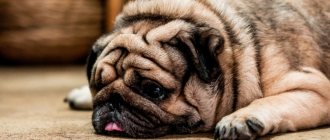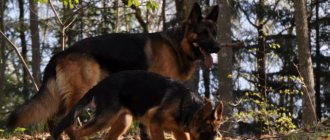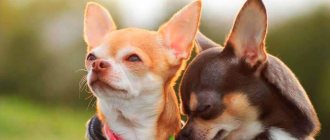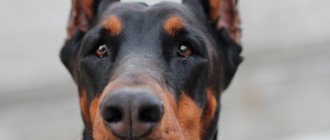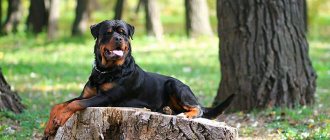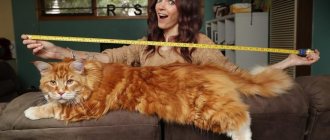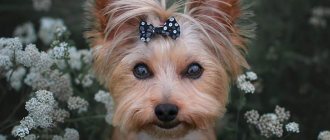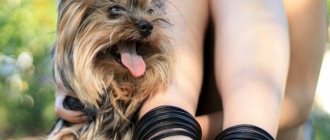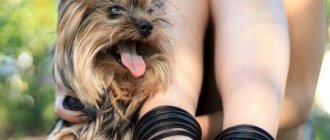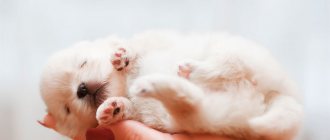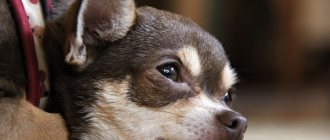A fat pug is a real hard labor for the owner and a burden in every sense for the dog itself. Is it worth allowing such a condition when the dog has difficulty walking, of course not. A responsible pug owner would never allow this to happen.
After all, a dog’s heart, circulatory system, and bone tissue can suffer from obesity. All together reduces life expectancy, and your dog may not live to see 10 years, much less. So, dear friends, we follow the correct diet, give only healthy foods and do not overfeed the already dense four-legged animal.
We will tell you what to do if something unexpected has already happened and your pug has recovered, how not to harm it and how to lose weight without harming the dog’s health.
How to measure a dog's size
To correctly measure the size of your dog you need to:
- do this at the same time of day and before the animal eats;
- the frequency of measurements depends on the age of the baby. So, at two months and earlier, measurements are taken every five days, from two to six months - every ten days, at six months and older - every month;
- Body weight is measured using ordinary scales. First you need to stand on them yourself and record the indicator. Then stand up with your pet in your arms. The difference between the two numbers is the dog's weight;
- To measure the dog's height, you need to take a measuring tape and place it vertically from the floor to the very top of the withers.
Distinctive features
Pugs are proportional, strongly built, square dogs. The closer the height at the withers is to the length of the body, the higher the individual is rated. Overall the breed is small. Both females and males are no larger than 32 cm . Their weight ranges from 6 to 8 kg.
Due to improper selection in the Middle Ages, Pugs acquired many congenital defects, so it is difficult to find the ideal dog. So, at the moment, individuals are distinguished that resemble terriers (refined and graceful) and bulldogs (larger, heavier and more muscular). None of the types is considered standard, but some dogs even take prizes at shows.
Judges place many demands on the shape of the Pugs' head. It should form a clear square without lengthening, narrowing or bulging. Although initially the correct skull should have looked like a monkey.
- The head is square, round, massive, but proportional to the body. No skull bones should be visible.
- The muzzle is abundantly covered with wrinkles (their size is also mentioned in the standard; the fold between the skull and muzzle should not be too large or small), square, short, but not upturned. The nose line is straight. The lower jaw is wide, the bite is of the “overshot” type (but insignificant).
- The nose is small, upturned, flat. Black color.
- The eyes are large, but not protruding. Set quite wide, almost in line with the nose. Dark and shiny.
- Ears can be either “button” or “rose”. Both types are allowed by the standard. Excessively long ears, low-set and half-raised ears are not allowed.
- The body is short, muscular, strong, and square in shape. Fat Pugs are disqualified. The body should be surrounded by wrinkles, but not Shar Pei-shaped. The top line is straight, the bottom line is tucked. The chest is quite wide with rounded ribs. The neck is of medium length, slightly arched, without dewlap but with skin folds.
- The tail is short, tightly curled into two rings and pressed to the lower back (one ring is acceptable).
- Limbs straight, parallel, strong. Excessively short or long limbs are considered a defect. The paws are not long (like those of a hare), but not round (like those of a cat). Well developed fingers. The movements are rolling, but not hobbling.
- Skin and folds. The skin is dense and elastic. The folds are symmetrical throughout the body. Of particular importance are the folds on the muzzle, frontal part and around the eyes, as well as around the head and neck. An additional advantage will be the folds on the wrists.
- The coat is harsh, short, and not fluffy. There is a slight extension on the tail.
- Colors: silver, peach, beige and black. Light colored pugs should have a black mask, darkening on the ears, paws, crest and forehead. Moles on the cheeks are characteristic.
Pug weight table by age
The table below shows the weight of a pug puppy by month.
| Dog age | Pet gender | |
| Male (in kilograms, +/- 400 g) | Female (in kilograms, +/- 400 g) | |
| At 2 months | 2 kg | 2 kg |
| At 3 months | 3 kg | 3 kg |
| At 4 months | 4 kg | 4 kg |
| At 5 months | 5 kg | 5 kg |
| At 6 months | 6 kg | 6 kg |
| At 7 months | 7 kg | 6.5 kg |
| At 8 months | 8 kg | 7 kg |
| At 9 months | 9 kg | 7-7.3 kg |
| At 10 months | 10 kg | 7.3-7.6 kg |
| At 1 year | 11-12 kg | 8-9 kg |
| At 2 years old | 11-12 kg | 8-9 kg |
| At 3 years old | 11-12 kg | 8-9 kg |
| At 4 years old | 11-12 kg | 8-9 kg |
Physical training
Just like a human, exercise is very important for an overweight pug, but you should be careful. Too much stress can lead to disastrous consequences, such as cardiac arrest. Gradually increase the duration of walks; for starters, 1.5 times is enough.
The most popular exercise for dogs is fetch the ball. It will keep your pet entertained and moving. After some time, you can begin to overcome obstacles, but you should not overdo it.
It is best to have a professional trainer create a training schedule. He will select the appropriate exercises and quickly get your dog in good shape.
Our article has now come to an end. Thank you all so much for reading. Remember that your pug's health depends primarily on you. Keep an eye on it so that your pet lives happily ever after. Was the material helpful? How much does your pug weigh? Write in the comments.
Why is a pug skinny?
If your pet weighs very little, this can be explained by several reasons:
- Malnutrition. The most dangerous thing is malnutrition in puppies that are just beginning to grow.
- The dog has no appetite. There may also be reasons for this.
- Infection with worms. This is a fairly common reason. To avoid damage to the body by parasites, you need to systematically deworm your dog.
- Lack of vitamins. Again, their deficiency has the greatest impact during puppyhood. Such a baby will grow up sick and weak.
What vitamins are needed?
Vitamins that a pug needs for good health:
- vitamin A . Necessary for the good development of pug puppies, including the period of mating, pregnancy, and lactation. It is found in tomatoes, greens, carrots, liver, milk, fish oil and egg yolk;
- vitamin B. To keep your pug's skin and muscles healthy and strong, this vitamin is needed. It is found in liver, brewer's yeast, dairy products and greens;
- vitamin C . Prevents diseases of the gums and joints, improves the body's immune system. It is found in fruits and vegetables;
- vitamin D. Necessary for a growing dog - it prevents rickets, strengthens bones;
- vitamin E. It is a reproduction vitamin and is needed by pugs during periods of mating and pregnancy. Contained in beets, carrots, greens and cereals.
Obesity in pugs
This is a very common problem in Pugs. Therefore, the owner should not give in to slack and treat the pet with food from his own table. Pugs are small dogs, so they gain excess weight quickly. Starting from a young age, the puppy should eat only according to a strict schedule, without unscheduled “snacks”. In order not to miss the onset of the disease, it is necessary to systematically weigh the animal.
However, the cause of obesity is not always severe overeating. Sometimes this is facilitated by disturbances in the functioning of the endocrine system, lack of physical and physical activity, and old age.
When is it time to lose weight?
Now let's look at when a pug needs to start losing weight.
First, it is very important to monitor your pet's weight. Owners who truly love their pets care about their health, and monthly weighing is a very important part of this care.
If you notice that your dog has gained weight, consider changing his diet. However, it is important to remember that before changing your dog's menu, you need to consult with your veterinarian. A good specialist will select the food that will quickly tone up your pet.
Secondly, obesity can be noticed by sight, so examine your dog regularly. If you look at the dog from above, you should see the waist (namely, the narrowed area of the body in front of the hind legs).
If it is not there, this is a sign that the pug has gained weight. The second way is to palpate the ribs. Run your hand along your dog's side: if everything is normal, the rib is not visible externally, but it can be easily felt.
If it doesn't, it's a sign that it's time for your Pug to lose weight. Another good way is this: examine your pet from the sides. You should see a smooth transition from the chest to the stomach. If the back is too wide or the pet's belly sags, this is a sign of obesity.
Diet tips
Feeding pug puppies
Veterinarians and dog handlers advise feeding small puppies with ready-made dry food, as it contains a properly balanced amount of vitamins. Around seven months or a little earlier, you can gradually switch your baby to natural food (if desired).
If the owner decides to feed the puppy natural products, he must correctly calculate the daily portion and do not forget about adding vitamin complexes to the diet.
If the owner decides to feed the baby food, you need to buy products of at least premium class, since economical budget granules are dangerous to the health of the animal.
Nutrition for an adult dog
The pug does not have chewing teeth, so it is necessary to cut meat and other food given to the pet into pieces. Meat should be cut larger, other products smaller.
In general, the pug diet should look like this:
- Raw lean meat - at least 2/3 of the entire diet.
- Boneless fish (only sea and lean fish) – 1-2 times a week.
- Sour milk - every day.
- Boiled vegetables, finely chopped fruits - every day.
- Thick buckwheat, rice and oatmeal porridges – 1-2 times a week. It is allowed to season with a piece of butter (or a spoonful of vegetable oil).
You cannot mix natural food with dry ready-made granules. Prohibited foods for dogs are:
- pasta and other flour products, including bread and pastries;
- semolina;
- fatty foods;
- smoked food;
- potatoes in any form;
- sugar and sweet products (sweets, lollipops, etc.).
Features of character and behavior
- Opinions about the character of Pugs vary greatly. Some people notice irresistible laziness and phlegmatic behavior in their pets, while others notice cheerfulness, activity and a positive mood. In fact, each Pug is unique. They can be true aristocrats or fidgets; it is almost impossible to understand how the puppy will grow up.
- All representatives of the breed are characterized by a complete absence of aggression, hunting and protective instincts. This dog was bred only as a companion. Pugs are loyal and loving, they actually follow their owner’s tail and strive to participate in all areas of his life.
Advantages
- These dogs are friendly, non-aggressive and sweet. Many people get such pets just because of their friendly, funny faces.
- Pugs are sociable and loving, they like to be near their owner and give him all the tenderness.
- They are neutral towards children and tolerant towards strangers, but may exhibit protective instincts and bark.
- Quite energetic, but despite this, they like to lie for a long time and watch TV.
- Another plus of the breed is that Pugs do not need long walks, or rather, they are contraindicated. These dogs are perfect for sedentary and elderly people.
- There is an opinion that a pet's temperament depends entirely on its color. It is believed that black Pugs are more active, which cannot be said about light Pugs, who like to spend time lying down.
We can say that this is one of the most intelligent decorative breeds. Pugs are easy to train, although the owner will have to deal with their stubbornness.
Flaws
- The main character flaw of Pugs is stubbornness. Yes, these are little lambs in a dog's skin. If they don’t like something, they may even be offended. Because of this, training becomes quite difficult and the educational process takes a long time. It is not easy to accustom such a dog to a daily routine and toilet.
- Such pets are really very trusting and kind. Dog thefts often occur on the street.
- Quite jealous. They do not like it when the owner pays attention to anyone else. In addition, Pugs cannot stand long-term loneliness and literally follow the heels of their household members.
- Caring for such a dog is intensive and difficult. Many people are frightened by this particular feature. The problem becomes skin folds and eyeballs. Pugs also often snore and sniffle. They can be mischievous and like to chew shoes and furniture.
Diet for Overfed Pugs
Diet is the main weapon in the fight against obesity in your pet. And to use it effectively, you need to know the rules for creating a healthy dog diet:
- It is strictly forbidden to give an overweight pug the usual canned food. The exception is a special dietary one, which contains a full range of nutrients.
- Reduce your daily food intake by 10%. We divide the number of feedings by four per day instead of the usual two. If the pet has become obese due to old age, then the frequency of feedings, on the contrary, decreases to once a day, or remains usual - twice a day. In the morning, the old pug is given light food like egg yolk or vegetables and porridge. And in the evening they give you lean fish or poultry.
- Among the permitted products are: white poultry meat, lean fish, kefir and other fermented milk. In addition, you need to increase your consumption of vegetables.
- It is necessary to add vitamins and minerals to the baby’s daily diet.
Another component of treating obesity in a pet is increasing activity. The duration of daily walks should not be less than an hour. You need to unfasten the leash more often and let the baby run freely. Active games will also come in handy. For example, with a ball or a stick. Veterinarians recommend sending your baby swimming, because while swimming in the water, he receives an even load on all muscles. But if the pug doesn’t like water, you can’t insist.
History of the origin of the species
Ancient China is considered the birthplace of Pugs. It was there that short-faced, square dogs similar to Pekingese were held in high esteem. By the way, they are identified as the ancestors of Pugs, but this has not been proven genetically. At that time, there were 2 similar breeds: Ha Pa and Lo Jie. The first were long-haired, while the second were most similar to modern Pugs.
Luo Jie could be kept by any person who had sufficient material income to support it, because such a dog was carried on special chairs by hired people, preventing the pet from becoming overloaded. Ha Pa were considered exclusively imperial pets, which were forbidden to be taken out of the palace.
There is an assumption that Luo Jie were bred by Buddhist monks. Such dogs were considered sacred and good luck. People believed that the folds on their foreheads formed special hieroglyphs.
Pug itself is considered Dutch. At first, this breed was called by different names. For example, the French called the dogs Carlins, in honor of the famous actor Carlino, whose stage mask looked like the face of a Pug. The English name " Pug " translates as " pug ". Throughout Europe, these dogs were known as boudoir dogs, they kept their owners warm in unheated spaces.
Pugs came to the European part of the continent thanks to active trade between China and France. This happened around 1550. The breed quickly gained popularity and spread to other countries. She was held in special esteem in Holland. The peach color of the dogs was likened to the state colors of the ruling Orange.
In addition, one of the favorites of Queen Mary II of Orange saved the king’s life during the war with Spain (16th century). The dog woke him up with his barking, warning him of the enemy's attack.
For a long time the breed was at the peak of popularity in France. Especially during the reign of Napoleon. The fact is that the Pug named Fortuna was the favorite of the bride of Emperor Josephine. But, after the return of Bourbon power, these dogs were no longer bred in pursuit of political goals. Indiscriminate selection and improper maintenance have worsened the gene pool of the breed. Pugs were on the verge of extinction.
In 1864, Queen Victoria demanded that a purebred dog be found. An individual was found, but at least one more was required for selection. She was brought from China, like many others. During this period, the breed branch was divided according to the colors of the dogs: the first was called “warmth of the sun” (beige and peach dogs), and the second “black of the night” (black and chocolate).
The first breed club was officially registered in 1883. Since that time, orderly and consolidated work has been carried out on the development of dogs. The standard was published in 1888.
The photo shows a black pug
What affects the development of a puppy?
Pugs usually gain weight quickly in the first couple of months. Genetic and hereditary factors have a great influence on the weight of a pug. Other factors influencing the development of puppies are the environment - pugs that feed well on breast milk in the first weeks of life are likely to develop and grow faster and larger.
It is also necessary to create a special diet for pugs to avoid future problems with excess weight.
Puppies need to be fed more often and more than adult animals, as they expend more energy during the growth period. Adult dogs of this breed need to be fed less often and less.
A balanced diet and physical activity are the key to your pet’s well-being.
The above data on the weight of puppies may fluctuate between 300-500 g above or below the norm - this is normal.
NOTE!
The pug is a dog that requires specific care. Careful selection of food for your pug will help him stay in good shape and in a great mood. In addition, daily walks with your pet are necessary to ensure that he does not develop rickets.
The diet should consist of milk porridges, vegetables, thick soups with meat and vegetables, cottage cheese and eggs.
